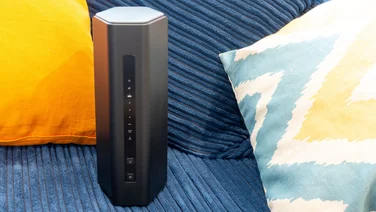To help us provide you with free impartial advice, we may earn a commission if you buy through links on our site. Learn more

- Great value for the two-node system
- Good overall Wi-Fi coverage
- Wider range of features than some competing meshes
- Merely acceptable performance
- “AI” promise is mostly froth
If you want wide-area wireless coverage with easy management, a mesh network is the way to go. The best systems can be very expensive, however, while cheap models tend to sacrifice performance.
D-Link’s M15 Eagle Pro AI falls squarely on the value side of the divide. It’s a complete Wi-Fi 6 mesh system – you can choose from two-node and three-node packages – for less than the price of many standalone routers.
And for those worried about speed, D-Link promises “AI-enabled capabilities that are always optimising and improving”. The idea of a mesh that intelligently works out how to deliver the best performance certainly sounds appealing; sadly this claim is mostly hot air, although the product itself does deliver solid coverage and a decent range of features for the money.
D-Link M15 Eagle Pro AI Mesh review: What you need to know
The M15 Eagle Pro AI Mesh is designed to replace your existing router, although the units can also act as wireless extenders set for your current network, if you set the system up in Access Point mode.
It’s sold as a set of two or three identical boxes, with claimed coverage of 370 square metres and 500 square metres respectively. Each unit contains a 2.4GHz radio supporting connections at up to 300Mbits/sec and a 5GHz transmitter that goes up to 1.2Gbits/sec with a channel width of 80MHz. Twin antennae in each unit support 2×2 MU-MIMO connections.
These are low-end numbers by Wi-Fi 6 standards. The best routers and mesh systems support link speeds as high as 4.8Gbits/sec these days, with twice the channel width and double the MIMO capacity. What’s more, this system doesn’t use a dedicated backhaul radio link, so when data is passed back and forth between mesh stations it eats into the bandwidth available for your devices. In short, it’s a solid modern specification but performance clearly isn’t the primary focus.

D-Link M15 Eagle Pro AI Mesh review: Price and competition
A two-node M15 system (part number M15-2) costs a mere £97. That makes this the cheapest Wi-Fi 6 mesh we’ve tested, even undercutting the Xiaomi Mesh System AX3000 – although it’s worth remembering that this model is not officially sold in the UK. Curiously, the three-node M15-3 bundle works out more expensive at £174, although that’s still fairly competitive for what you get.
Another option in this price range is the Amazon Eero 6: here, the twin-pack is quite a lot more expensive than the D-Link M15 at £142 but the three-unit bundle is a more reasonable £187. The Eero has some issues, however, including a severe shortage of Ethernet connectors.
If you can stretch the budget past the £200 mark, it’s worth considering the TP-Link Deco X20 (£210 for three nodes) or Netgear’s Orbi RBK352 system, at £215 for the two-unit package. The TP-Link Deco X50 is another contender, offering three units for £249 and including TP-Link’s HomeShield service for basic network security and parental controls.
While each of these meshes has its own strengths and weaknesses, they’re all dual-band designs. For the best speeds you’ll need a tri-band system, such as the Netgear Orbi RBK752. At £370 it’s a big step up in price but it does a much better job of keeping up performance at range.
READ NEXT: Our guide to the best VPNs for privacy and security
D-Link M15 Eagle Pro AI Mesh review: Design and features
The M15 units are small and almost perfectly cubical, measuring 92 x 92 x 93mm. They’re quite discreet, with an unflashy white casing and a tasteful pastel blue top. A single multicoloured LED on the front of each one shows its status.
At the rear of each node are two gigabit network sockets. Although these are marked “internet” and “Ethernet”, both can be used for LAN connections to the satellite units. On the primary unit, however, the “internet” socket really is needed for your internet connection, so if you want to connect multiple wired clients you’ll need to invest in a network switch.

Aside from a reset button and a WPS control that’s all there is to the hardware but there’s more to discover in the web console. The M15 mesh runs the same firmware as D-Link’s R15 Eagle Pro AI router, which means you get a fair spread of management features.
One nice surprise is the configurable SPI firewall and, while the QoS manager doesn’t let you prioritise different traffic types, I like the way you can temporarily or permanently boost the priority of an individual device with a few clicks. The incoming VPN server allows you to securely access a home NAS or shared printer over the internet.

D-Link also makes it easy to extend your network. M15 units aren’t currently sold singly, but you can buy a D-Link E15 range extender for £63 and add it to your mesh with a few clicks – or pair an R15 Eagle Pro AI router running in extender mode.
There are some disappointments, however. It’s good to see parental controls, since not all meshes include these, but the M15’s restrictions are really only useful for setting time limits, as there’s no web filtering beyond a manual blocklist.
READ NEXT: Best Antivirus
The vaunted AI features meanwhile are a big disappointment. For example, the Wi-Fi Optimiser does nothing more than periodically switch your network onto the clearest Wi-Fi channel, while the AI Mesh Optimiser works out the best route between mesh nodes. These are worthy functions, but they represent a very generous definition of “artificial intelligence”. The AI Assistant, meanwhile, just generates regular reports of your internet usage.
As with the R15 router, some features of the M15 mesh can also be managed via the Eagle Pro AI mobile app, including guest network control, time limits for kids and QoS priorities. Clicking on the “Advanced Mode” button, however, simply opens the web console in your mobile browser. It’s usable, but the wide layout and tiny text are a terrible fit for a smartphone touchscreen.
D-Link M15 Eagle Pro AI Mesh review: Performance
When it comes to the M15’s performance there are two questions to answer: Is the system as a whole any good? And, is it worth paying the extra for the third node?
To find answers, I tested the M15 in my customary way. First, I set up the primary unit in my study at home, with the Ethernet port connected to an Asustor Drivestor 4 Pro NAS appliance. Another M15 unit was plugged in in my usual location for secondary mesh nodes, at the opposite side of the adjoining bedroom.
I then went around the house with my test laptop, equipped with its 2×2 Intel AX210 Wi-Fi 6 network card, and measured upload and download speeds from various locations. Finally, I connected the third unit in the living room and repeated the tests.
You can see the results below, along with the speeds I recorded from rival meshes for comparison:


I noted above that the M15’s hardware design doesn’t appear to prioritise performance, and here’s how that shakes out. While same-room downloads are pretty speedy, the M15 proved slower overall than any other Wi-Fi 6 mesh, whether configured with two or three nodes.
Indeed, these results demonstrate that adding more mesh units doesn’t always help performance. In most rooms I got effectively identical speeds regardless of whether I was using two or three M15 units; evidently a two-storey, three-bedroom maisonette is small enough to make a third station largely superfluous.
And adding the third unit in the living room actually reduced download speeds in that location. The reason isn’t hard to fathom: when there was no mesh node in this room, the laptop connected through the ceiling to the primary mesh unit. Once I’d placed an M15 unit in the same room, my laptop locked onto that stronger signal instead, resulting in a slower indirect route to the NAS. The lesson is, consider carefully where you situate your mesh stations.
D-Link M15 Eagle Pro AI Mesh review: Verdict
Clearly, the performance of the M15 Eagle Pro AI mesh is nothing to get excited about. Any idea that the AI features might make up for the limitations of the hardware is wishful thinking, and the firmware has other quirks and shortcomings too.
That doesn’t mean the system is useless. The two-node setup gave me admirably consistent coverage both upstairs and downstairs, regardless of how many rooms away I was from the primary unit.
And, while speeds don’t match up to pricier meshes, they’re absolutely fine for typical internet duties. Even 10MB/sec (the slowest download speed I saw) is three times as fast as required to stream 4K video; it’s enough to deliver the full bandwidth of an 80Mbits/sec broadband connection.
There’s definitely a place in the mesh market for the M15 Eagle Pro AI, therefore. For a medium-sized home, where stable coverage is more important than sheer performance, it’ll do a very satisfactory job of wiping out the not-spots for an unbeatable price. If you want a faster or more glamorous networking solution then you’re welcome to pay more – as much as £1,500 for the Netgear Orbi RBKE963 if you really want to – but this humble little mesh might just be your smartest buy.






